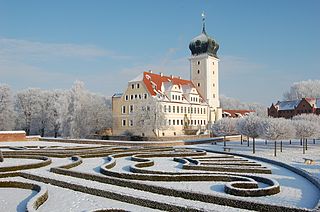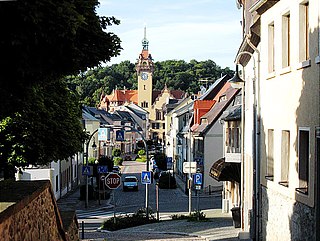
Meissen is a town of approximately 30,000 about 25 km (16 mi) northwest of Dresden on both banks of the Elbe river in the Free State of Saxony, in eastern Germany. Meissen is the home of Meissen porcelain, the Albrechtsburg castle, the Gothic Meissen Cathedral and the Meissen Frauenkirche. The Große Kreisstadt is the capital of the Meissen district.

Colditz is a small town in the district of Leipzig, in Saxony, Germany. It is best known for Colditz Castle, the site of the Oflag IV-C POW camp for officers in World War II.

Augustus II, most commonly known as Augustus the Strong, was Elector of Saxony from 1694 as well as King of Poland and Grand Duke of Lithuania in the years 1697–1706 and from 1709 until his death in 1733. He belonged to the Albertine line of the House of Wettin.

Radebeul is a town in the Elbe valley in the district of Meißen in Saxony, Germany, a suburb of Dresden. It is well known for its viticulture, a museum dedicated to writer Karl May, and a narrow gauge railway connecting Radebeul with the castle of Moritzburg and the town of Radeburg. The Meißen area, where Radebeul is located, is one of the northeasternmost areas where wine is grown in the 21st century.

The House of Wettin is a dynasty of German kings, prince-electors, dukes, and counts that once ruled territories in the present-day German states of Saxony, Saxony-Anhalt and Thuringia. The dynasty is one of the oldest in Europe, and its origins can be traced back to the town of Wettin, Saxony-Anhalt. The Wettins gradually rose to power within the Holy Roman Empire. Members of the family became the rulers of several medieval states, starting with the Saxon Eastern March in 1030. Other states they gained were Meissen in 1089, Thuringia in 1263, and Saxony in 1423. These areas cover large parts of Central Germany as a cultural area of Germany.

Bischofswerda is a small town in Germany at the western edge of Upper Lusatia in Saxony.

Delitzsch is a town in Saxony in Germany, 20 km north of Leipzig and 30 km east of Halle (Saale). With 24,850 inhabitants at the end of 2015, it is the largest town in the district of Nordsachsen.

Grimma is a town in Saxony, Central Germany, on the left bank of the Mulde, 25 kilometres (16 mi) southeast of Leipzig. Founded in c. 1170, it is part of the Leipzig district.

Dresden Castle or Royal Palace is one of the oldest buildings in Dresden, Germany. For almost 400 years, it was the residence of the electors (1547–1806) and kings (1806–1918) of Saxony from the Albertine House of Wettin as well as Kings of Poland (1697–1763). It is known for the different architectural styles employed, from Baroque to Neo-renaissance.

Lommatzsch is a municipality located in the district of Meißen in the Free State of Saxony, Germany.

Großschirma is a town in the district of Mittelsachsen, in Saxony, Germany. It is situated 7 km northwest of Freiberg. It was formed from the administrative union of the municipality of Großschirma and the town of Siebenlehn, including their districts, on 1 September 2003.

Mügeln is a town in the district Nordsachsen, in Saxony, Germany. It is located 9 km southwest of Oschatz and 14 km northwest of Döbeln. The town has a population of approximately 5,808 people.

Radeburg is a town in the district of Meißen, in Saxony, Germany. It is situated 19 km east of Meißen, and 18 km north of Dresden. The main tourist attraction is the narrow-gauge Radebeul-Radeburg railway line that connects Radeburg and Radebeul via Moritzburg. The painter and illustrator Heinrich Zille was born in Radeburg.

Waldheim is a town in Mittelsachsen district, in Saxony, Germany.

The Electorate of Saxony, also known as Electoral Saxony, was a territory of the Holy Roman Empire 1356–1806. It was centered around the cities of Dresden, Leipzig and Chemnitz.

Moritzburg Castle or Moritzburg Palace is a Baroque palace in Moritzburg, in the German state of Saxony, about 13 kilometres (8.1 mi) northwest of the Saxon capital, Dresden. The castle has four round towers and lies on a symmetrical artificial island. It is named after Duke Moritz of Saxony, who had a hunting lodge built there between 1542 and 1546. The surrounding woodlands and lakes were a favourite hunting area of the electors and kings of Saxony.

Rammenau (German) or Ramnow is a municipality in the district of Bautzen, in Saxony, Germany. It is known as the birthplace of the well-known German philosopher Johann Gottlieb Fichte (1762–1814).

Prince Ernst Heinrich of Saxony, Duke of Saxony was a member of the Saxon Royal Family. Ernst Heinrich was the youngest son of the last King of Saxony, Frederick Augustus III, and his wife Archduchess Luise of Austria, Princess of Tuscany. From 1923 through 1945, Ernst Heinrich was Administrative Chief of the association "Haus Wettin – Albertinische Linie e.V.".
Prince Rüdiger Charles Ernest Timo Aldi of Saxony, Duke of Saxony, Margrave of Meissen was a disputed head of the Royal House of Saxony, and the only agnatic great-grandson of the last King of Saxony, Frederick Augustus III.
Daniel Timo Prinz von Sachsen, Herzog zu Sachsen, Margrave of Meissen, politician and entrepreneur, is the oldest son and heir of Rüdiger, Margrave of Meissen, a disputed Head of the deposed Royal House of Saxony. Daniel was a candidate to become King of Poland. He is a founder of the Wettin Forest Service and the Wettiner Golf Cup.

























